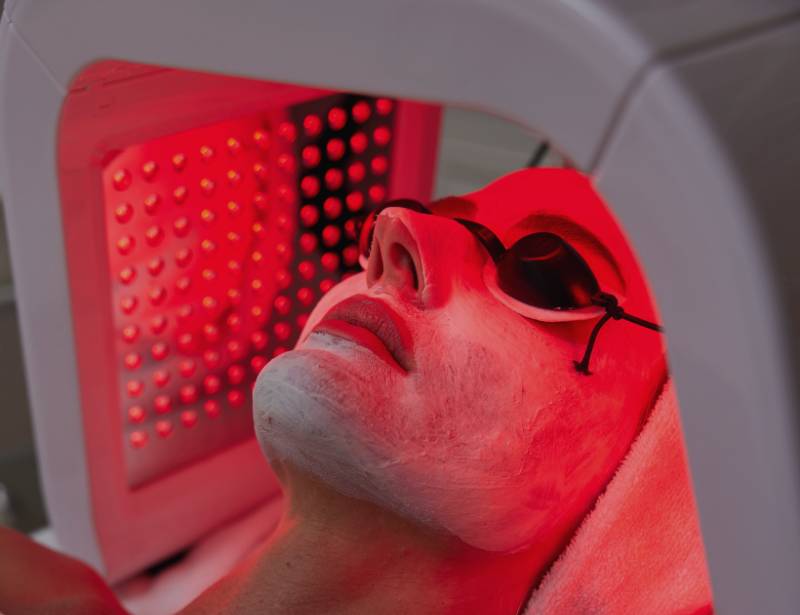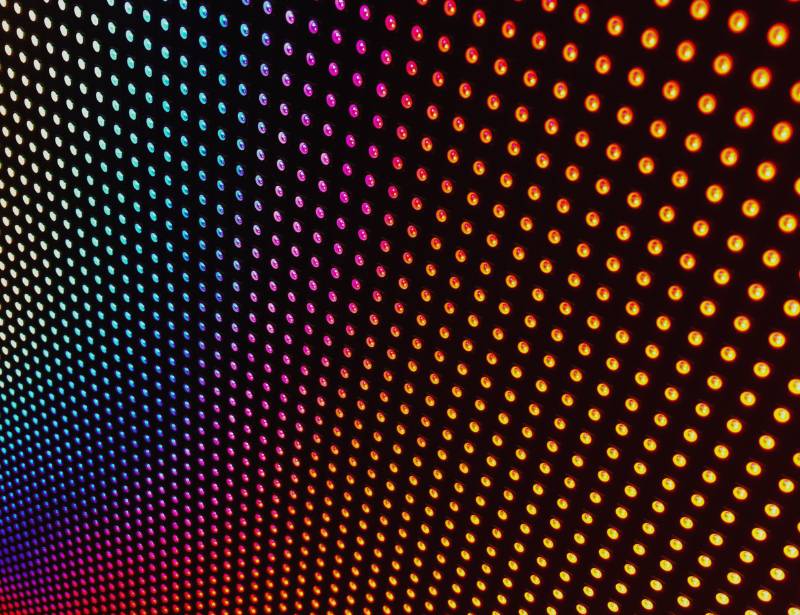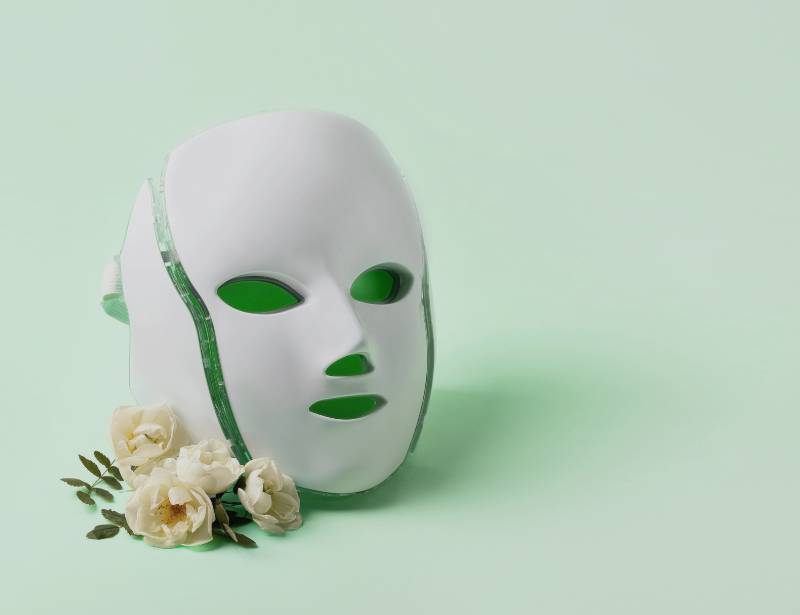
What is LED Light Therapy?
Exploring the benefits of LED light therapy can provide valuable insights into its effectiveness for various skin conditions. LED light therapy is a non-invasive treatment that uses different wavelengths of light to target specific skin concerns. The therapy works by penetrating the skin at different depths to stimulate cellular processes. Red light, for example, is commonly used to promote collagen production, reduce inflammation, and improve overall skin tone. On the other hand, blue light is effective in targeting acne-causing bacteria and reducing breakouts.
LED light therapy is a safe and painless procedure that can be used on all skin types. It's often used to treat acne, reduce fine lines and wrinkles, and improve the overall texture of the skin. The treatment is quick, with sessions typically lasting around 20-30 minutes. Many people find LED light therapy to be relaxing and rejuvenating, with visible improvements in their skin's appearance after a series of treatments. By understanding what LED light therapy is and how it works, you can decide about whether it's the right treatment for your skin concerns.
What does LED Light Therapy do?
LED light therapy works by utilizing different wavelengths of light to target specific skin concerns and stimulate cellular processes at varying depths within the skin. The different colors of LED light penetrate the skin at different levels, triggering various reactions. For example, blue light is commonly used to target acne-causing bacteria, while red light can help reduce inflammation and promote collagen production, aiding in anti-aging effects.
The therapy helps improve skin texture, reduce wrinkles, and even out skin tone by promoting collagen and elastin production. Additionally, it can help with acne by killing bacteria and reducing inflammation. LED light therapy also enhances circulation, accelerates tissue repair, and decreases redness.

How much does LED Therapy cost?
The cost of undergoing LED therapy can vary depending on factors such as treatment duration and the specific type of LED device used. On average, a single session of LED light therapy can range from $25 to $85. However, some clinics or spas might offer package deals for multiple sessions, which can help reduce the cost per session.
Home LED therapy devices are also available for purchase, with prices ranging from $25 for handheld devices to $300 for larger panels. These home devices can be a cost-effective option for those who want to incorporate LED therapy into their skincare routine regularly.
Keep in mind that the cost of LED therapy can also be influenced by the location and reputation of the clinic or spa offering the service. Higher-end establishments or those located in metropolitan areas may charge more for LED therapy sessions. It's essential to inquire about pricing options and any available discounts before committing to a session to ensure you're getting the best value for your money.

Different kinds of LED light Therapy?
Various types of LED light therapy offer specific benefits for skin rejuvenation and overall wellness.
Red light therapy is commonly used to promote collagen production, reduce inflammation, and improve skin tone. It can also help with wound healing and reduce the appearance of fine lines and wrinkles.
Blue light therapy, on the other hand, is effective in targeting acne-causing bacteria, making it a popular choice for treating acne and blemishes.
Green light therapy focuses on reducing hyperpigmentation, calming sensitive skin, and balancing skin tone. This type of therapy is often used to help even out skin discoloration and reduce redness.
Amber light therapy promotes lymphatic circulation, which can help reduce swelling and puffiness in the skin. It also aids in the absorption of skincare products, making them more effective.
Each type of LED light therapy targets specific skin concerns, so it's best to choose the one that aligns with your skincare goals for the best results.
Does LED Light Therapy Work?
To know the effectiveness of LED light therapy, it's important to understand how this treatment can address your specific skin concerns. LED light therapy works by emitting specific wavelengths of light that penetrate the skin at varying depths. Different wavelengths target different skin issues. For instance, blue light is often used to target acne-causing bacteria, while red light can stimulate collagen production and reduce inflammation. This therapy is effective because the light energy is absorbed by cells in the skin, triggering natural cellular processes that can result in various benefits.
LED light therapy has been scientifically proven to be effective for a range of skin concerns. Numerous studies have shown its efficacy in improving acne, reducing inflammation, promoting wound healing, and enhancing overall skin rejuvenation. Many users report visible improvements in their skin's texture, tone, and clarity after consistent LED light therapy sessions. It's a non-invasive and gentle treatment option that can complement other skincare routines. Overall, LED light therapy can indeed work wonders for many common skin issues.

What doesn't LED Light Therapy treat?
LED light therapy isn't effective in treating deep wrinkles or sagging skin. While LED light therapy offers various benefits for the skin, it's important to understand its limitations. This treatment primarily targets issues on the surface of the skin and may not penetrate deeply enough to address concerns such as deep wrinkles or significantly sagging skin.
Additionally, LED light therapy isn't a suitable treatment for severe acne or deep scars. While it can help improve overall skin condition and reduce acne inflammation, it may not provide the level of treatment needed for severe or cystic acne. In these cases, it's advisable to consult with a dermatologist for more targeted solutions.
Furthermore, LED light therapy isn't designed to treat medical conditions such as skin cancer or precancerous lesions. If you have concerns about suspicious moles or skin growths, it's essential to seek medical advice promptly and undergo appropriate diagnostic procedures. LED light therapy is meant for cosmetic purposes and shouldn't be used as a substitute for medical treatment when dealing with serious skin issues.
How long does it take for LED Light Therapy to work?
When starting LED light therapy, you may begin to notice improvements in your skin's appearance after a few sessions. The exact time it takes for LED light therapy to work can vary depending on the specific skin concern being addressed. For mild acne, you might see results within a few weeks of consistent treatment. However, for more severe acne or other skin conditions, it may take several weeks to a few months to see significant improvements.
Consistency is key when it comes to LED light therapy. To achieve the best results, it's essential to follow the recommended treatment schedule and not skip sessions. Most professionals suggest starting with multiple sessions per week and then gradually reducing the frequency once you start seeing improvements. Remember that LED light therapy is a gradual process, and patience is required to see long-lasting results.

Who should not have LED Therapy?
If you have certain medical conditions or are pregnant, it's important to consult with a healthcare provider before undergoing LED light therapy. Some conditions may make you unsuitable for this treatment. People with epilepsy or a history of seizures shouldn't undergo LED light therapy, as the bright lights can potentially trigger seizures.
Additionally, if you have a known sensitivity to light, such as in the case of certain skin conditions or eye conditions like retinitis pigmentosa, LED light therapy may not be suitable for you.
Furthermore, individuals who are taking photosensitizing medications should avoid LED light therapy, as the light can interact with these medications and cause adverse effects. If you have a history of skin cancer or are currently undergoing treatment for skin cancer, it's important to avoid LED light therapy as it can potentially stimulate the growth of cancerous cells.
Always prioritize your health and safety by discussing your concerns with your physician before starting LED light therapy.
Are LED Therapy Safe?
For your safety and well-being, it's essential to understand the safety aspects of LED light therapy. LED therapy is considered safe when used as directed. The light emitted by LED devices is non-ionizing, meaning it doesn't carry the same risks as UV light. This makes LED therapy a safer option compared to other light-based therapy, such as laser treatments.
LED therapy is non-invasive and doesn't cause burns or skin damage when used properly. However, it's mandatory to follow the recommended guidelines for treatment duration and intensity to avoid any potential side effects. While LED therapy is generally safe for most people, individuals with light-sensitive conditions, such as epilepsy or those taking medications that increase sensitivity to light, should consult a healthcare provider before undergoing LED treatments.

Conclusion
In conclusion, LED Light Therapy is a safe and effective treatment for a variety of skin concerns, including acne, inflammation, and skin rejuvenation.
With different wavelengths targeting specific issues, this non-invasive therapy offers noticeable results in improving skin texture and tone.
While LED therapy may not be suitable for everyone, it's a cost-effective option that can be easily incorporated into skincare routines for visible improvements in skin health.

